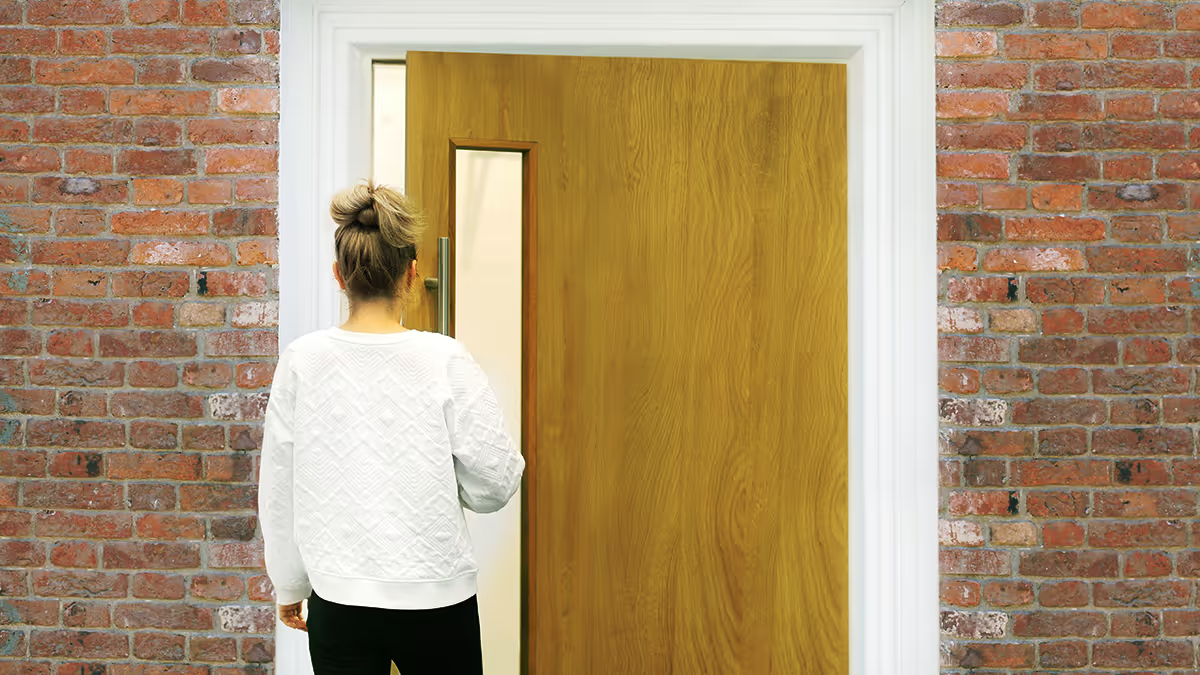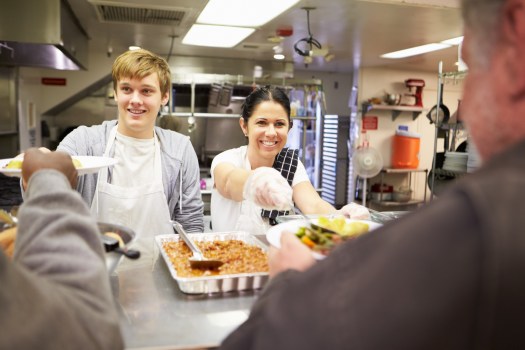Yearbook curriculum
Looking for inspiration, design tricks, how to make a great cover, promoting your yearbook and engaging your community?
Most recent

Yearbook in 60 days - part 1: yearbook quickstart
Two types of people start a yearbook towards the end of the school year: those handed the crown minutes ago, and those with hundreds of other tasks for the school and now have “free” time to begin one more. Creating a yearbook in 60 days is doable. Promise. We’re breaking it down for you in four parts, each with two weeks' worth of tasks and inspiration. Consider this your yearbook easy button.
Throughout the series, there will be resources for inspiration and help. Watch this quick video to see
- How to log into the Ediotr Help Center for exclusive step-by-step articles
- Where to find resources to share with parents
- Where to get design inspiration, lesson plans, and more
Yearbook (yes, it is a verb) along with us on Facebook, Instagram, and TikTok.
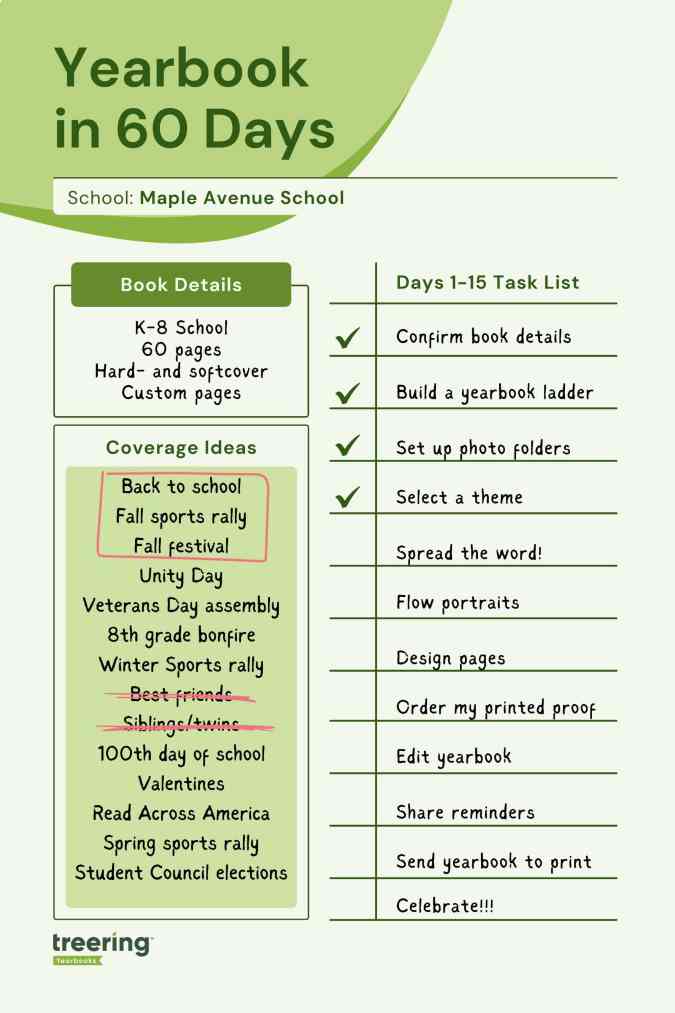
1. Confirm your book details
It’s tempting to jump into the glamorous yearbook tasks such as theme and design. There’s a little back-end work you need to do first for two reasons:
- Your dates will direct your workflow
- Your yearbook details determine the price of your yearbook
Dates
With Treering, you can change your dates at any time. Remember, your three-week turnaround begins once you hit Print Ready, and send your book to the printers.
For parents: custom pages deadline
Parents will see this date on their account, indicating when they should purchase the book or complete any customized pages. It doesn't impact the printing schedule.
Some parents {raises hand} need a little extra time and reminders to complete theirs. Treering recommends a cushion of about two weeks.
For editors: finish editing yearbook deadline and estimated delivery date
This is your one and only deadline for editing the book—and you set it! Select a date three weeks from when you want to distribute it.
You won’t be able to edit the delivery date directly. Treering automatically populates it by the date you choose for your deadline. If you need additional time to capture year-end events, no problem. Your three-week turnaround will align with your new deadline.
In part four, you’ll learn how to send your yearbook to print.
Pricing
The yearbook price will change in real time when you adjust the page count and cover finish. The best way to firm up your page count is to create a ladder (more on this below).
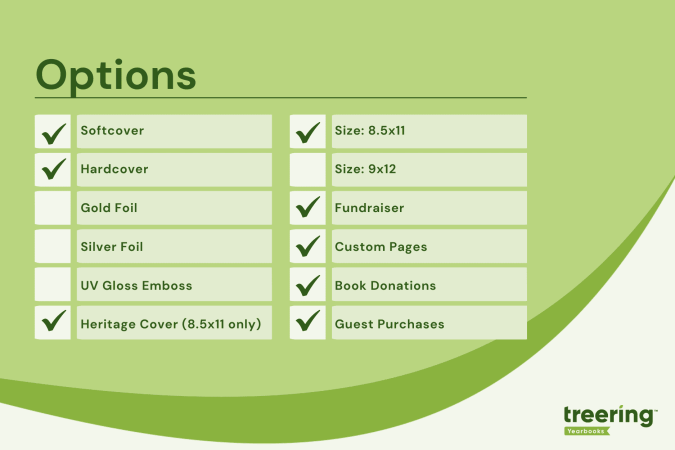
Shipping and index
Bulk shipping to the school is free. If you select this option, you choose how to receive your yearbooks:
- Sorted alphabetically
- Sorted by grade and then alphabetically
- Sorted by teacher and then alphabetically
Alternatively, many online or hybrid academies and schools electing to do a fall delivery choose the ship-to-home option. When parents order yearbooks, they also pay a flat rate shipping fee.
Book details resources
- Video: Chief Editor Dashboard
- Free Live Webinars: Treering’s Yearbook Club
2. Build a ladder
A ladder is a chart that represents the pages in a yearbook. It’s the industry-standard tool to help you stay organized. On it, you allocate a topic to each yearbook spread (that’s yearbook-ese for two facing pages).
Because yearbooks tell the story of the year, there isn’t a codified order to how things go. Typically, they include
- Academics: school distinctives, achievements, and activities
- Events: fundraisers, activities, performances, before- and after-school activities
- Organizations: clubs and teams
- People: student, staff, and faculty portraits
- Thematic content: larger books employ divider pages to separate sections
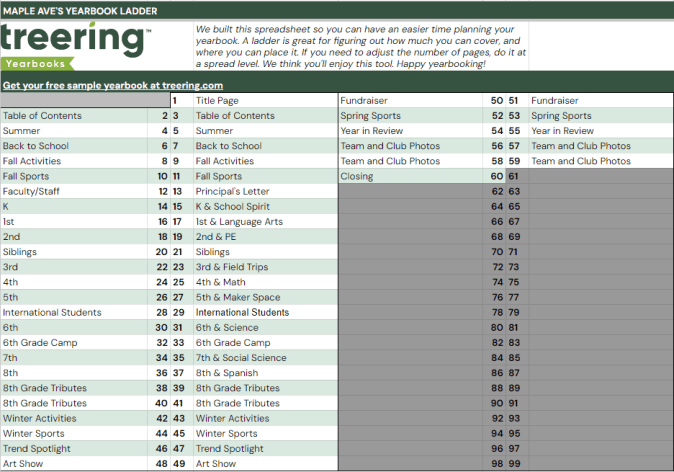
To build your ladder, look at the last few yearbooks and the latest school calendar.
- Brainstorm the non-negotiable events, sections (people, arts, sports), and yearbook traditions
- Brainstorm features, specials, and theme-related content
- Decide how you will organize the book
- Allocate spreads
We love doing this digitally because it can be fluid. If your page count is looking overwhelming because of time or budget, combine some topics. Remember to update your page count on your book details so it matches your plan.
Yearbook ladder resources
- Google Sheet: Free Yearbook Ladder Template
- Google Sheet: Example Ladders (there’s a separate tab for elementary, middle, K-8, and high school examples)
3. Set up photo folders
The best photo organization tip I can give came from Yearbook Hero Katie Parish. She said to create folders to mirror your ladder. This way, you know you are collecting content for every single spread you planned. And spoiler alert, your design process will look like this.

By investing the time to set up folders this way, you can simplify your workflow. Just open the corresponding folder and click, drag, drop, and done!
In the video below, you’ll see how to add folders and set up crowdsourcing features. Notice the Art Show folder is Editor Only. This means only you, the editor, can place photos in this folder. After activating their accounts, parents will see the yellow “public” folders and be able to share. At any time, you can make a folder Editor Only and vice versa.

In Part Two, we will give you five strategies to fill those shared folders with content so you can build your pages.
Photo organization resources
- Article: Creating Folders and Subfolders (this is one of those Editor-only resources, so you'll need to log in)
- Article: School Photos
4. Choose a whole-book look
The Styles menu is where it’s at: you can create font and photo presets, adjust your margins (#TeamMarginsOff), and select the theme for your yearbook. Because I have 60 days to create a yearbook, I am skipping all the customization options and selecting a pre-designed theme to give my yearbook a unified look.

For a cover-to-cover drag-and-drop experience, the design team recommends the following Treering themes:








Theme resources
- Google Slides: All Treering’s Yearbook Themes
- Blog Category: Theme Ideas and Inspiration
Remember, get to know your dashboard; it’s the first thing you see each time you log in. Part two of this series will outline the promotion tools built in the yearbook builder and start the design process.
Yearbook with a friend
You can also recruit team members to help you build and market the yearbook. With Treering, you can set permissions and assign pages to help delegate your workload. Additionally, parents, teachers, and students can help gather content and promote book sales.
Organization resources for yearbook teams

Yearbook proofing tools
Raise your hand if you do your best proofing after the yearbook goes to print. We've all had that cringe moment when you notice two baseball players' names interchanged in the sports section or the student who joined the second semester flowed with the wrong class. We can all agree: proofing is critical for the yearbook creation process. Consistency and the proper tools will help you ensure no mistakes slip through the cracks.
One-time: printed proof
Would you like a copy of your yearbook before distribution day to check your fonts, colors, layout, cover texture, and photo quality? We've got you.
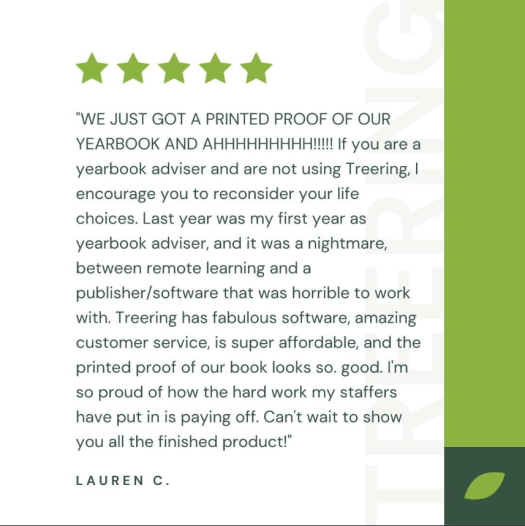
Once your yearbook is approximately 70% complete, order a printed proof of your yearbook to review the following:
- Cover alignment and bleed
- Portraits (accuracy, name size, and font)
- Gutter
- Bleed and margins
- Font choices, sizes, and colors
- Background contrast
- Spelling and attribution
- Photo clarity and color

Monthly: use PDF proofs
Print out a hard copy. Errors that are missed on the screen often jump out on paper. Create PDF proofs of class, event, club, and athletic pages to provide to the appropriate stakeholders for their review. Ask them:
- Is the content accurate? Is anything missing?
- Are names spelled correctly and referencing the correct person?
- Do these photos accurately represent the page's content and our student body?
Remember they need some time to review it, and should it require changes, you will need time to incorporate them.

Text proofreading tips
Read all captions, pull quotes, and headlines out loud. It may feel silly, and once you do it, you will see and hear the value:
- Tone, word choice, and sentence structure pop when you read them out loud
- If all your writing sounds the same, you may want to mix up sentence structure or type
Proofing yearbook quotes
Proofing is essential if your school uses expanded captions, pull quotes, or <gasp> senior quotes. A transcription tool for interviews, such as Otter.ai, which integrates with Google Docs, is handy for recording conversations.
Quotes must not be taken out of context. We do not alter quotations, even to correct grammatical errors or word usage. If a quotation is flawed because of grammar or lack of clarity, it may be paraphrased in a way that is completely true to the original quote. If a quote's meaning is too murky to be paraphrased accurately, it should not be used. Ellipses should be used rarely and must not alter the speaker’s meaning.
AP Style Guide
(Here's an article from CBS News and one from Slate that addresses language learners to review with your students.)
Sharing is caring: use printed proofs to tease the book
This isn't the first time we’ll make this suggestion, and it won't be the last.
Ongoing: rubrics and checklists
The best time to begin proofing yearbook spreads is after you’ve finished each page and well before you need to go to print. Informal editing can happen on screen with an editor or adviser. We also highly recommend peer editing on a projector with the whole team. Use a rubric to help guide the conversation.

Proofing and editing aren't a one-and-done thing. (Sorry not sorry!) It takes time to craft the perfect story and to create a solid layout from scratch. And if DIY is not your thing, the thousands of layout templates in the Treering library are at your disposal.
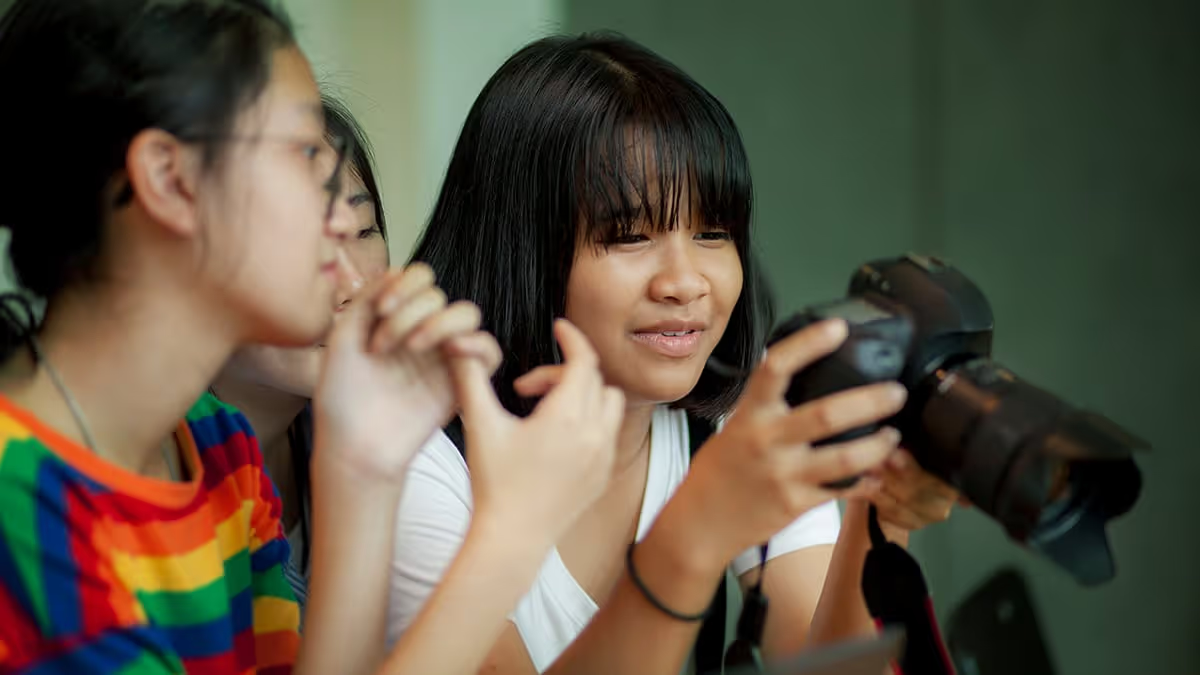
Teaching yearbook: 5 photography mini lessons
Improving yearbooking skill sets is an ongoing process, and we sometimes forgo instructional time as deadline season creeps in. Using these five mini-yearbook lessons, you'll be able to improve your photography skills with a DSLR, mirrorless, or cell phone camera while still having plenty of time for yearbook production.
Lesson 1: rule of thirds
Imagine your photo divided into a tic-tac-toe grid, with two horizontal and two vertical lines, creating nine parts. Instead of placing your subject dead center, try aligning them along these gridlines. The asymmetry adds interest to your composition.

Action should flow across your photo, not off it. The same goes for eyes: you want your subject looking in.
Try it!
Head out to the school courtyard and practice the rule of thirds with your classmates. Practice taking both vertical (portrait) and horizontal (landscape) portraits, ensuring your subjects are placed along the gridlines for a visually pleasing result.
Lesson 2: angles in composition
By experimenting with these angles, photographers convey different emotions, perspectives, and stories in their images.

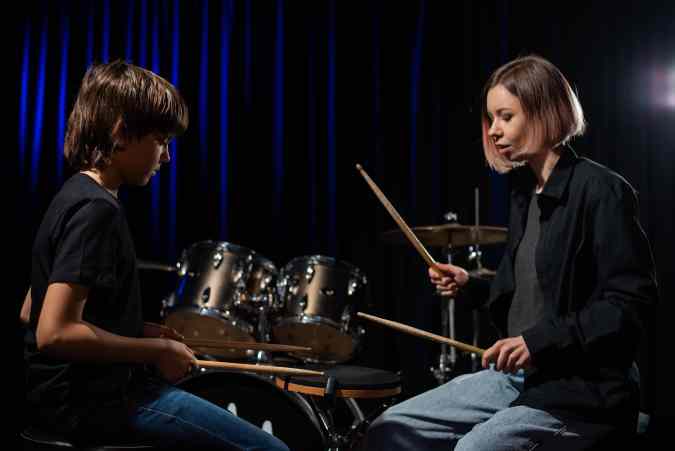

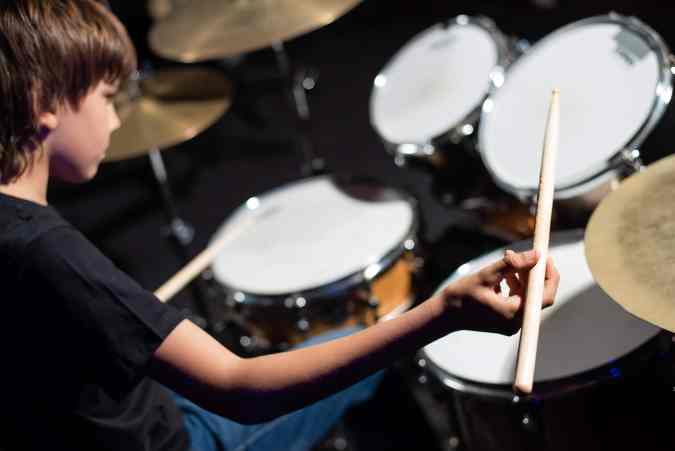
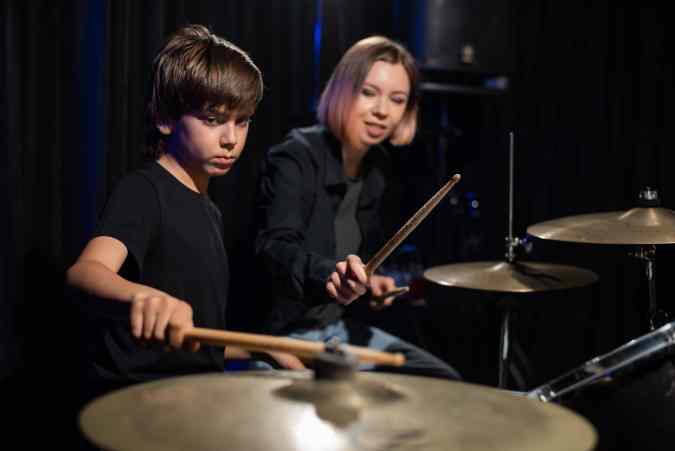
While these photos have the same subject, the variety of angles tells a different moment in the story.
Practice each of these photo angles during your lessons.
- Eye level: This is most common because the photographer captures subjects at the same height as the camera.
- Worm’s eye view: This varies between dramatic and unflattering, so use with caution. By lowering the camera, the subject appears larger.
- Bird's eye view: A great view to use when students are collaborating on a project, this captures scenes from above.
- Close-up (Macro): Cameras and their phone counterparts usually have a setting to help focus on small details or subjects up close. This is great for art class or some science labs (not dissections) when you need to reveal intricate textures and patterns.
- Wide-angle: Oh, the 0.5 that is trending! A traditional wide-angle shot captures a broader view and exaggerates perspective.
- Over the shoulder: Sometimes, the story is in the work, not the student. (This also helps with camera-shy students.)
- Overhead angle: For flat lays (e.g., what’s in my backpack modules), shoot downward from an overhead position.
Try it!
Stage a student at work in the classroom. Taking turns, yearbook photographers should circle and move around the subject, snapping photos using the above angles. For more application, one student can “direct” the photoshoot, explaining which angle to practice and how to achieve it.
Lesson 3: cell phone photography
Cell phone cameras make yearbook photography more convenient for students–it’s a familiar and comfortable way to document the day. While DSLR and mirrorless cameras give more control over light, cell phones are lightweight and on your person nearly 24/7.
As with a traditional camera, you want to hold the phone steady with both hands, elbows in. This adds stability and reduces blur, especially in low-light situations.
Additionally, remember to zoom with your feet. My yearbook adviser gave me this photography lesson back in the 90s, and it still holds. This means photographers move to the subject and avoid a single, stationary vantage point. Ultimately, the composition and photo quality will be better.
By pinching and zooming, you reduce the pixels in the photo, thus destroying its quality. It’s better to zoom and crop once the photo is on your spread.
Try it!
Turn the grid on your phone cameras (Android, iPhone) and repeat the previous exercises on the rule of thirds and angles. Remember, the principles of photography are universal.
Yearbook PSA
With a camera in most teachers’ and parents’ pockets, you have an additional photography crew on campus. Creating shared photo folders and communicating how to get pics in them allows more stories and POVs to be told.
Lesson 4: depth of field (portrait mode)
Depth of field is a crucial aspect of photography, influenced by the aperture setting on a camera. The aperture is the physical opening in the lens that controls the amount of light entering the camera. The wider the aperture opens, the more light passes through.
Portrait mode on a cell phone mimics depth of field by using depth mapping, selective focus, and, sometimes, multiple lenses to create a shallow depth of field, similar to what is achieved with a wide aperture on a traditional camera. (Click here for the full technical read.)
Try it!
Using both a camera and a cell phone, take headshots of your yearbook staff. Try f/22, f/8, and f/1.4. Repeat, focusing on objects, such as a baseball or pointe shoes, in the hands of a student.
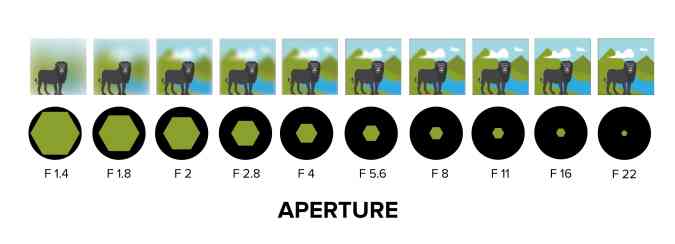
Lesson 5: assessment
Every unit needs a culminating activity. And since we love gamifying yearbook class, here is a photography Bingo card. You can use this in a few ways:
- Coverall: assign students the card to complete
- Traditional: make it a race to get five in a row
- Collaborative: as a group, work through the card; you may assign teams a row or column
- Minute-to-win-it: Give students a time limit (more than a minute) to achieve as many tasks as possible

What makes a great yearbook photo?
The short answer: storytelling photos.
A yearbook narrative of the entire school year. Candid moments, such as in-class discussions, reactions at a game or awards ceremony, or spontaneous interactions between friends, are emotive. While posed pictures have their place–the portrait section is full of them–action shots bring a sense of vitality and excitement to your yearbook.
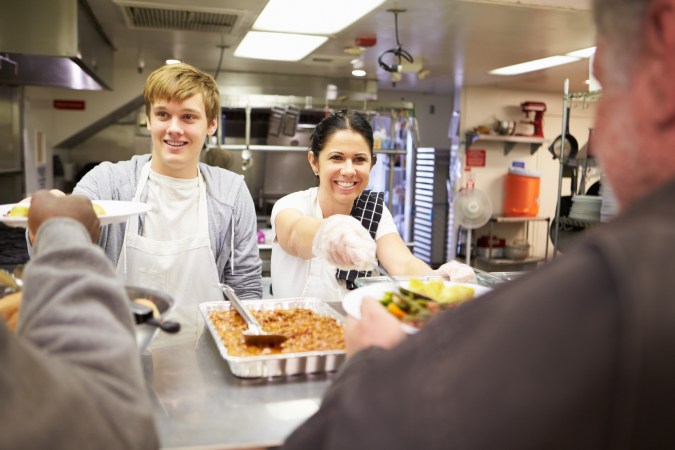
By applying the composition tips above, your yearbook photography is already diversified. The variety of angles and depth of field alone will increase the visual appeal of each layout.
Taking multiple shots of your subject is a great way to ensure you get the best pose, reaction, and composite. Deleting unwanted images only takes seconds and not getting the most effective image in the first place is a missed opportunity that can’t be duplicated.
Additional photography resources for yearbook classes and clubs:

Teaching yearbook: graphic design
In my credential program, I missed the comprehensive graphic design, marketing, journalism, editing and proofreading, photojournalism, contract negotiation, and volunteer management track that would prepare me to be a yearbook educator. Over the years, an idea library on my classroom shelves slowly came about: other school's yearbooks, folders of magazine spreads worth emulating, Treering's Big Idea Book and Marketing Un-Stumped, plus gobs of digital files. If your yearbook advising journey is relatable, try these small changes that will make an impact on your book's visual look.
This blog was adapted from Yearbook Hero's Lauren Casteen's Teaching Yearbook: Graphic Design webinar. If you're interested in joining this professional community to grow your yearbook pedagogy or to score some PD hours, register for one of our free webinars on Zoom.
Graphic design self-analysis
On a scale of 1-5, how do you currently feel about teaching graphic design? Keep in mind teaching and doing are two different skill sets.
Mild, medium, or spicy?
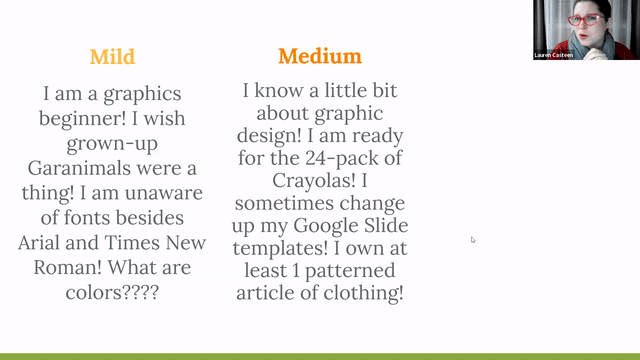
Below are some suggestions based on your self-reflection. This year, you may be Mild, and next year, you'll apply some of Casteen's tips and be Medium with a hint of Spicy.
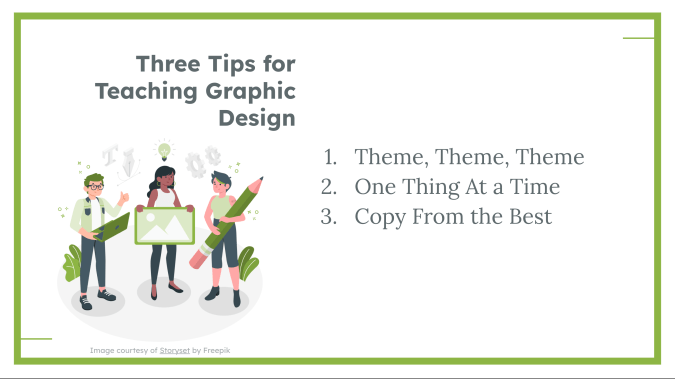
Yearbook theme
A theme helps keep your yearbook unified so it doesn’t look like a different person did every page (even if they did).
A theme does a lot of the graphic design work for you: it's like giving your students fill-in-the-blank notes as opposed to having them copy them by hand.
Lauren Casteen
Mild
Choose a yearbook theme from Treering's Theme Gallery. Commit to it by using it for your whole book: each theme package includes layouts, backgrounds, and graphics you can mix and match. Using powerful tools such as auto page layout, you can create a beautiful book while learning.
When you're ready, move to Medium.
Medium
Casteen falls into the Medium category: she says they start with a Treering graphics package that supports the verbal theme, and then they adapt it. The 2022 Polaris team wanted a newspaper feel to go with "A Year to Remember." The staff blended QWERTY, which had a modern media feel, and Venture, which is filled with vintage items and textures, to create their book.
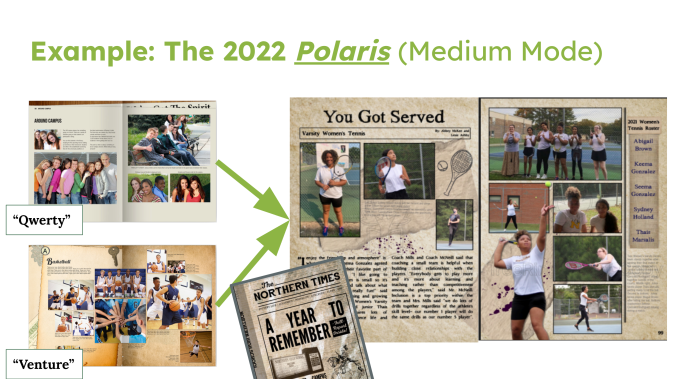
Spicy
You can design your own theme. Have students come up with a color palette using an online palette generator; use Treering’s font bank to match fonts. To build a unique look, consider including student drawings or artwork.
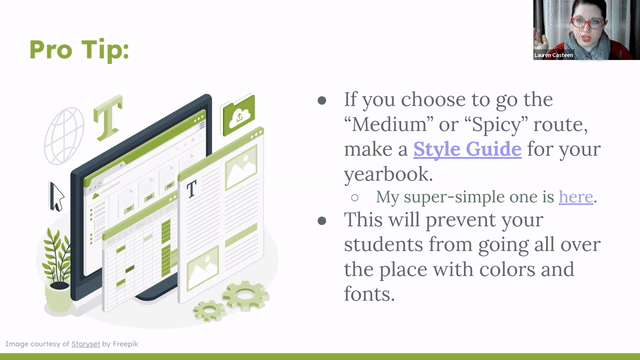
A style guide will help your designers remain focused. It will also help you, as an adviser, provide detailed feedback on how to improve the design. Here's Casteen's.
One graphic design concept at a time
Since graphic design is an entire professional field, and you could spend beyond four years in college studying it, there is entirely too much graphic theory and practice to complete in one semester or year of yearbook. By breaking it down, you can focus on what's essential for your team this year and build as you and your team grow. Here's how to do it:

Find the Golden Ratio blog and others on the design page of the blog.
Balancing first-year and returning yearbookers
If you have returners on your team, some of them may be Medium or Spicy, and that's OK. Now that you have some scaffolding, tailor your projects for your student by skill level.
You can revisit each topic each year with your returning staff members to make it more challenging. For example, maybe your newcomers are choosing a pre-made layout instead of doing it themselves, or maybe they are designing a layout for a module rather than an entire yearbook spread. Focusing on one specific skill at a time makes it easier for you as the teacher to differentiate.
Copy from the masters
The masters are "masters" for a reason. Whether it is a magazine ad or a social graphic, inspiration is out there. You can apply a photo treatment you saved from Pinterest on a divider page or emulate a car ad layout in your yearbook.

Get started in graphic design
Lastly, here are the action items from Casteen's session. Select one for your launch plan:
- Pick a theme if you haven’t (or maybe choose a few for your students to narrow down)
- Look through Treering blog articles to find a focus skill to teach
- Make yourself a Sandbox page and start playing around
- Find inspiration for a page to replicate
If you're interested in joining another of our working webinars, check out the entire Yearbook Club webinar schedule.
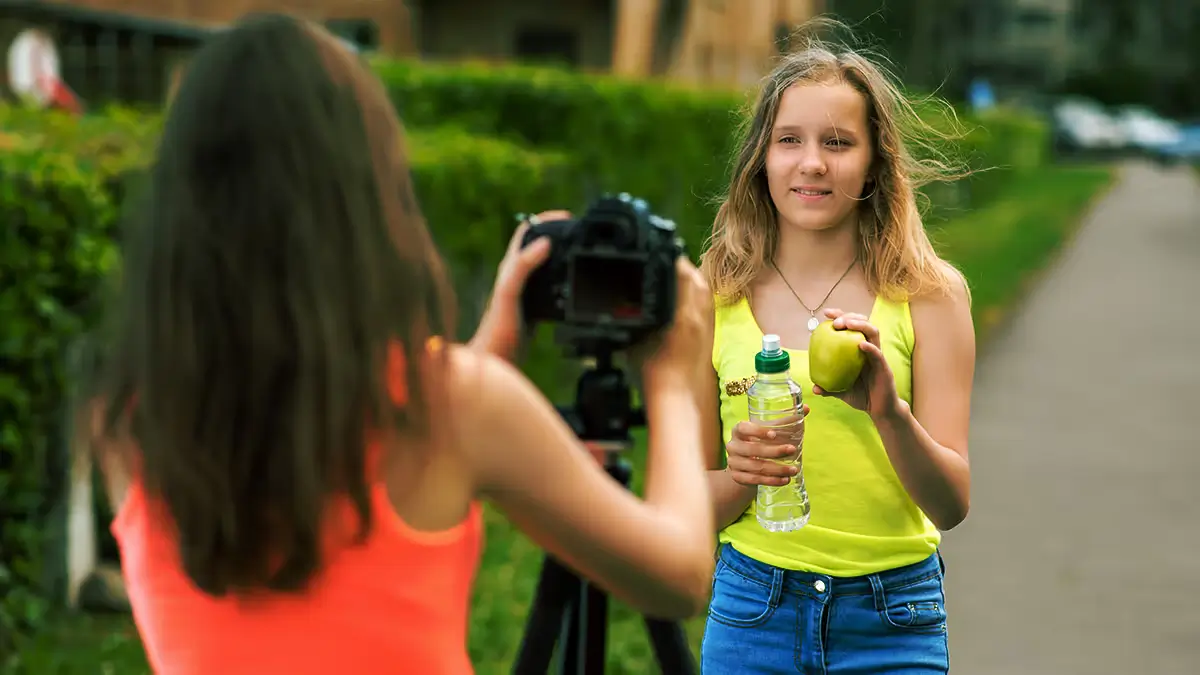
How to build a yearbook staff manual
If I could return to year one of advising, I’d draft a staff manual. Yearbooking (yes, it’s a verb) would have been much simpler. I’m not talking about contract negotiation so much as how to deal with sports editors who cannot get a ride to a game or reporters who only interview their friends. Or the “finished” spread with “Lorem ispum dolor” still filling the caption boxes. Or how to tell a senior parent you cannot legally publish a screenshot from a mall photographer’s online proof system. Phew.
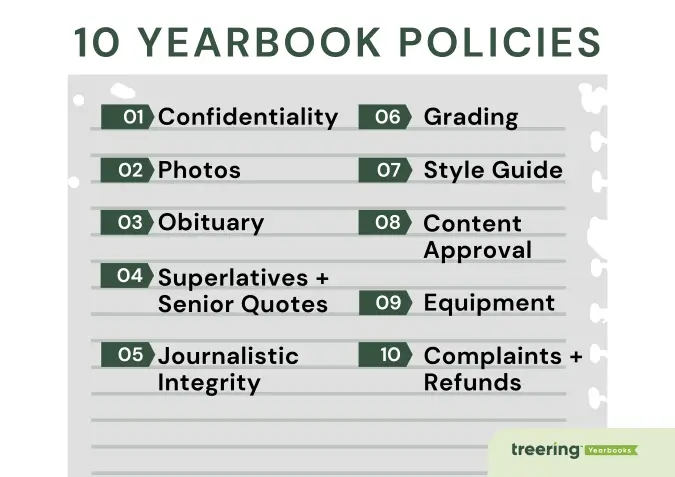
Tenets of your program
A tenet is a doctrine you hold to be true. The first section of your staff manual should define your non-negotiables. These could be class culture and coverage goals. They could also include specific ways your yearbook program aligns with your school’s mission. Or, you could take a different approach and schedule workdays to create your book in chunks.
It’s your call. You determine what is valuable to your community. Here's what's in mine.

Coverage is a non-negotiable because our school claims to be a “People-first” learning community. If a student is excluded from the historical record of our campus, the yearbook team undermines the mission. That said, we’ve never had 3x coverage for 100% of the 423-person student body; on average, it’s 94-96%. And because Treering’s three-week turnaround allows us to add the students who transferred in through mid-April, hardly anyone is ever a zero.

Considerations for elementary schools
Middle and high schools use yearbook policies to govern student roles, responsibilities, procedures, and behavior; adult teams might need to establish guidelines for
If your group is parent-led, there may be turnover. These policies will help the next adviser.
Yearbook team policies
By taking time to craft some policies for your staff manual, you will also codify what your program looks like. For example, if you have a large class (or two) completing the yearbook, you will want to have procedures for group and editorial board communication, chain of command, and the like. A team of five will not.
For a smaller yearbook team, it helps to establish boundaries to prevent burnout. Use your policies to protect one another such as how you will prioritize coverage when you can’t be everywhere.
Parent groups, yearbook classes, and clubs of any size also need job descriptions (see the next section).
Organizing your staff manual
Try to keep this under five pages, including the rubrics and/or checklists. Admin needs to sign off on these. Physically. That signature will go a long way when a parent or student challenges you.
Here are ten policies to include in your yearbook staff manual:
1. Confidentiality
Use this section to outline what you keep quiet and what you share pre-distribution.
2. Photos
What guides the bulk of your content?
3. Obituary policy
This is the toughest policy to craft while grieving. I learned the hard way. A group text from the vice principal requested an emergency staff meeting before school. Two students died in an automobile accident. One was racing without a license. The other was walking home.
Momentarily putting aside the denial, anger, and bargaining, we had to decide how to honor two lives. Thus, the following became our policy:
If within press time, Warrior Yearbook will provide a ¼ page space with the following:
No additional information will be included. All student ads will feature a family-submitted photo and will have parent approval. Next of kin will provide the photo and approval for staff memorials.
Here are more examples of obituary policies.
4. Superlatives and senior quotes
These are two of the most controversial areas between your yearbook covers. Add relevant dates, submission guidelines, crowdsourcing avenues, etc., to your policies.
Part of your yearbook superlative policy should include:

Personal opinion: Instead of senior quotes that focus on one group on your campus, why don’t you improve your journalism by building expanded captions into your designs? This way, you have quotes on every page from every grade. Now that’s people first.
If senior quotes are a golden calf, craft a policy that outlines
- Character or word limits
- Requirements for originality
- Vetting process (yes, we will look up that timestamp)
5. Journalistic integrity
Use this section to define how you will legally license and attribute outside content, and the role of AI in your newsroom. (Chances are, your district already has a written policy you can cite.)
This is also a great spot to explain the characteristics of reporting: it’s free of editorializing, defamation, or discriminatory content. What safeguards will you include?
6. Grading
Yearbook is the hardest “easy A” my students ever earned. (Wait for it…) Because of that misconception, include spread checklists and grading rubrics in this section so there is no question come progress report time. This is also a great area to outline your workflow and deadline schedule.
7. Style guide
This section provides clear instructions on theme elements to ensure consistency across the yearbook. With these decisions made early on, your team can focus on what truly matters: content.
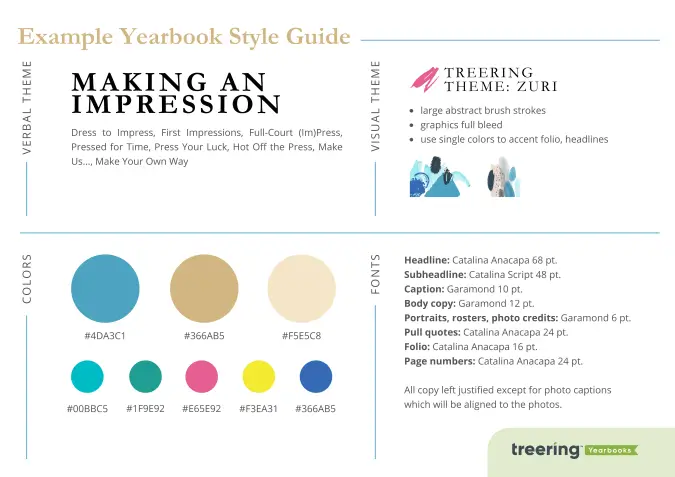
Many advisers stop there. I would push you to expand your yearbook style policy to include writing.
.webp)
8. Content approval process
Who approves layouts, photos, and written content, and what is the order of approval? If you have mini-deadlines for reviews and revision, include them here. Treering advisers, allow yourself time to order and review your printed proof.
There may be some overlap with your grading section, and that’s OK.
9. Camera/equipment checkout procedure
This section of your yearbook policy manual should clearly outline the rules and expectations for borrowing, using, and returning yearbook equipment. Here's what you might include:
Bottom line: this should complement your district policy on technology usage.
10. Complaint policy and refunds
Yearbook staff job descriptions
After a disastrous first year where everyone created their own editor title, an experienced adviser sat me down and said, “You need to spell it out.”
That nugget provided the missing piece to my yearbook classroom management.
If you’re a teacher, yearbook is another class. It requires scaffolding and instructional time. It’s also a business: you’re creating a project that requires financial resources. Use the job descriptions below to organize your team, create a chain of command, and align your grading expectations.
If you’re a parent volunteer working with other volunteers, use these job descriptions to provide role clarity for your team. (And if all else fails, we have a blog for that too.)
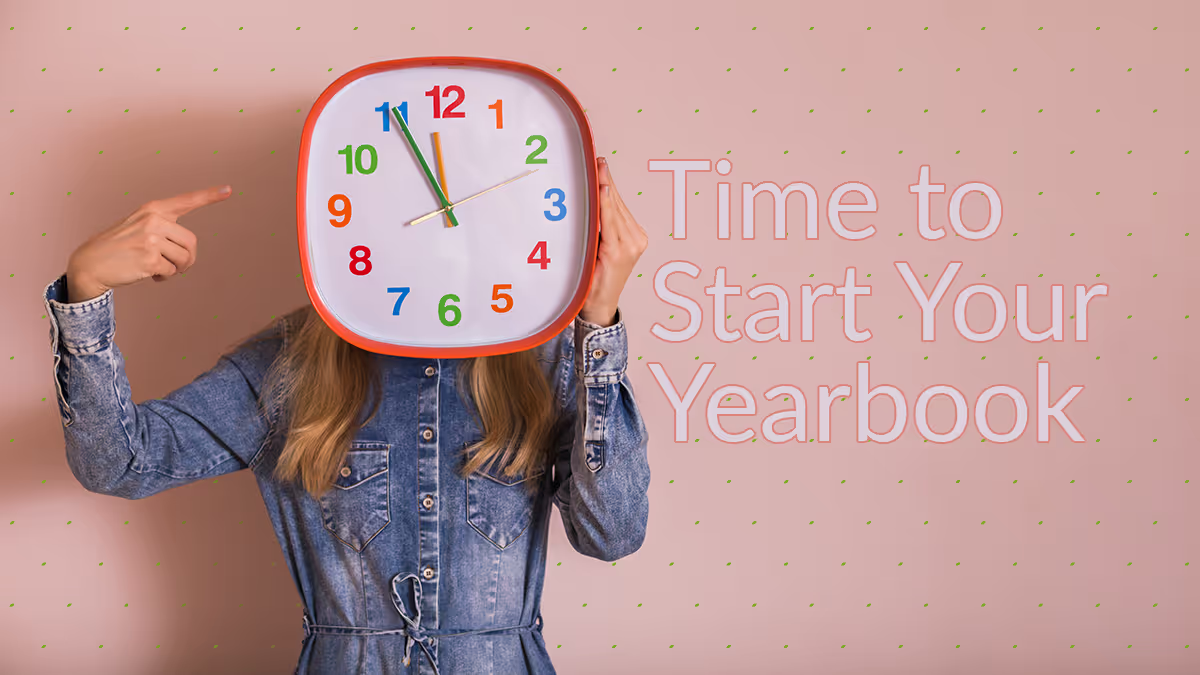
Create a quick, easy, and beautiful elementary school yearbook
With most of the school year in the proverbial book, we are counting down until summer vacation. End-of-the-year celebrations aren't complete without a yearbook. If you're the one wearing the yearbook coordinator crown, it's time to circle the wagons and quickly create your elementary school yearbook without sacrificing style. We have live webinars on Wednesdays to help jumpstart your second semester.
Step 1: upload your student roster
Your first step is a quick visit to the front office (remember to bring some lattes) to get a community and student roster. This seems tedious. It will save you hours if you do this first. You will easily be able to
- Tag to ensure inclusivity or to create an index
- Start marketing and selling your book
- Receive your yearbooks sorted by your choice of grade, teacher, or last name which will save you tons of time once they arrive
(We promise, you'll thank us later.)
Step 2: get the word out
With an updated student roster, you can now effectively communicate with your community and launch marketing campaigns that support yearbook building and orders. Examples of communication that will help you build a better book include emails asking for photos, how to purchase books, and special features like creating personalized pages and showing your students/parents how to create e-signatures.
If you really want to ramp up sales and raise awareness of your yearbook project and photo needs, use this month of Instagram, Facebook, TikTok, and Twitter content. There's also a full marketing module in our free yearbook curriculum.
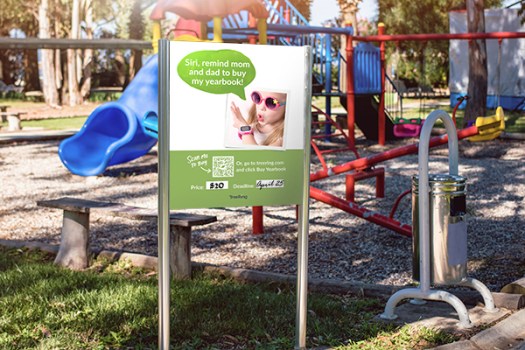
Step 3: collaborate with your community
Following strong communication, you are set up to collaborate on the yearbook with ease. Crowdsource photos from school staff, other parents, coaches, and students.
When possible, assign class pages to others. No yearbook coordinator is an island (or something like that). By building a team, you'll capture more, include more, and stress out less!
Step 4: upload your students' portraits
Whether your elementary school was able to take professional portraits, or you are sourcing portraits from parents, upload these to your yearbook next. Your yearbook provider should have a solution for adding these to your book. You can even use these yearbook spreads to add more content.
Step 5: build your book
Now that you’ve connected with your community and begun sourcing ideas and visuals for your yearbook, you’re ready to select and set up your book themes and styles. In addition to designing your own themes, Treering offers a free library of professionally designed themes. Each theme package includes layouts, font pairings, and graphics to tie your look together. You can also 100% customize your own.
Set spreads aside for
- School events such as fun runs and book fairs
- Sports (If your school doesn't have teams, crowdsource photos of students on their outside sports team)
- Holidays
- Trends
- Clubs
- Class favorites
Build a beautiful yearbook with features like auto-page layouts that magically lay your photos out beautifully on a spread or pre-designed pages that cover the Best of the Year and Year in Review plus student-generated content through fill-ins for a quick elementary school layout.

Step 6: set your yearbook to print ready!
Drop the yearbook and walk away. In all seriousness, hit “print-ready” to send your files to the printers and, if you're using Treering, you'll quickly have your books in hand in three weeks or less! If for any reason you want a little more time, it’s easy to adjust print-ready deadlines too. As the yearbook coordinator, you're in charge!
Step 7: distribute the yearbook and celebrate!
All this work is worth celebrating! Work with your parent group to host a yearbook signing party. It doesn't need to be fancy or cost you additional money; this could be something special like
- Playing music at lunch
- Offering a jeans day to yearbook buyers if you're a uniform school
- Allowing yearbook purchasers to bring a stuffed animal to school
- Setting up signing tables at a year-end school event
QR Code is a registered trademark of DENSO WAVE INCORPORATED.

How to get local media stoked about your yearbook
It’s common for school leaders to underestimate the newsworthy aspects of their school’s yearbook. They may think, “Our school is too small, so why would anyone outside of our students’ immediate families care about what’s going on with our yearbook?” Throughout a school year, consider all of the work that’s put toward building the book, the stories gathered, the candid photos captured, the skills gained, etc. Local media care about what’s going on in the community, and if they never know about it, there’s no opportunity for them to share with their greater audience. It’s time to consider getting local media completely stoked about your yearbook program!
1. Identify newsworthy aspects of your program
Oftentimes, yearbook-focused stories are going to resonate the most with smaller, hyperlocal outlets within a school’s community. This could include newspapers (print and online), TV, radio and even community newsletters. What you may think is a “meaningless story” could in fact impact readers in your hometown.
The following are high-level ideas to consider when thinking about working with local media:
- Position your yearbook adviser, or even the entire yearbook staff, as your school’s “hometown hero.” How are they positively impacting the school? What unique stories have they been able to capture for the yearbook that will pull at the heartstrings of the community?
- Reporters don’t want to talk to companies, they want to talk to people. Is the yearbook editor, parent coordinator, or even principal, media-prepped and comfortable speaking with reporters about the program?
- Local media tend to love stories with a multi-generational angle. How long has your yearbook program been in place? What unique, new aspects of the program can be shared? Do you have anyone on your yearbook team whose mother, grandmother, etc., was also involved in yearbook at the school years prior?
- Yearbook cover contests are a great opportunity to share a photo of the winning cover with media. Is this a contest that’s been occurring for years? Is it new? Are local artists involved? Reporters appreciate being given stats (i.e., years doing XYZ) as it helps strengthen a story.
- Share your successes. Has your yearbook earned recognition from your publisher?
2. Contact the right people
Depending on the size of the media outlet, some stations or publications have reporters that cover specific beats, while others that have a smaller staff have reporters that cover a wide variety of stories. If the outlet has a reporter that covers education, or more specifically K-12 education, this is someone to consider when your yearbook program has a story to share. Otherwise, reaching out to a general contact at an outlet, even if it’s for a general introduction if you’ve never worked with them before, is a great place to start.
It’s important to be professional, thorough, and to the point when reaching out to reporters and news outlets. Think about how yearbooks themselves convey stories through carefully selected phrases and high-res photos. Reporters are looking for the same: meaningful stories with images to support them.
3. Write a press release
Writing press releases is a common practice for businesses that want to announce a new product or feature, an award win, contest results, a new hire, etc. As it relates to a yearbook program, a press release would be most appropriate when announcing a yearbook contest award win, for example. Or if your school has never had a yearbook program and they have plans to launch one in the new year, this would be an opportunity to share a press release with local media.
So what should you include in the press release? Here’s an example to reference and a free press release template.
- Strong headline and subhead
- 3-5 body paragraphs (try to ensure that the press release is no longer than a page)
- A quote or two from leaders or subject matter experts to support the announcement
- Boilerplate at the bottom
- Contact person and their information (i.e. phone number, email address etc.)
Promote your yearbook program
In order for your yearbook program to flourish by increasing yearbook sales and growing your yearbook team, people need to know:
- What the yearbook program is all about and the importance of having a yearbook for students.
- How to get involved, and the specific steps to do so. Share the “how, what, why, and when” details if you really want your outreach efforts to make an impact. Consider creating a Facebook group for parents if you’re needing to recruit staff.
Treering's In the News page has plenty of examples of newsworthy yearbook programs.

The only yearbook timeline you'll need
Project manager. Social media marketer. Volunteer luncheon coordinator. Teacher liaison. Journalist. School historian. Memory maker. Yearbook coordinators wear all these hats and more! Below, we’ve taken one thing off your to-do list and compiled all the things on the definitive yearbook timeline so your planning and production resources are in one place.
When Last Year's Book is Complete...
Don't freak out. Keep scrolling if you were just handed the reins to the yearbook.
Fall
If there's one thing we hear from advisers around the globe, it's that they wish they started earlier! And while we can’t give you the gift of time, we can hook you up with some ideas to save you some.
Create a Plan
(Note to self: planning and controlling are two different things.)
It's impossible to think about yearbooks without considering yearbook themes. Whether you use a pre-designed one or create your own using Treering's design application, make sure it tells the story of your school this year.

Gather the school calendar, and PTA-sponsored events, previous yearbooks, and, with your team, start your ladder. This will be the overarching plan for the year(book). Your yearbook details should align with your ladder.
From there, add your team, create shared folders, and decide how to assign spreads. You’ll want to schedule follow-up meetings and track progress on this timeline.
Pre- and post-event check-ins ensure expectations are set and met.
Tweet
Start Marketing
When we think of marketing, we think of yearbook sales. It’s so much more. Your marketing plan should include
- Crowdsourcing efforts
- Yearbook staff recruitment
- Yearbook sales
No one will know what you do (create the most epic yearbook ever), what you need (photos, photos, and more photos), and how they can be a part of it (upload photos, join the team, host a party) if you don’t tell them.
Back to school is the ideal season to begin selling your yearbooks for two reasons: early discounts and the opportunity to earn free yearbooks. We’ve created a marketing plan template so you can stay organized.
If you are using your yearbook as a fundraiser, once again, work backward from your goal. For instance, is the PTG trying to earn money for more books in the library or playground equipment? Is your yearbook team trying to invest in new equipment? How much per book is needed to earn that amount of money?
Gather Content
August through November offer myriad opportunities to capture content and begin building your book:
- Student orientation
- First day
- Halloween
- Yerdsgiving
- Classroom shots
- Homecoming
- Spirit week
- Fall sports

Seize the [Picture] Day
Portraits comprise 40-60% of the average yearbook. If you aren’t on a first-name basis with your school photographer, it’s time to change that.
Touch base with your photographer and double-check they will export the photos in PSPA format (this is industry standard, but not everyone uses it) and confirm how they will deliver them to you. Copy your picture day coordinator on all correspondence (and offer up this professional school photographer's advice).

Winter
When you hit winter on the timeline, there is a shift at school: everyone becomes vacation-focused, and the list of things to do multiplies. (Late to the party? We have you covered with our yearbook quick start guide.)
Stay the Course
By now you have a rhythm: Your team has their assignments and together you’re tracking progress. Fall event pages are drafted and in the yearbook. Portraits should arrive momentarily. You follow up every event with an ask for additional POVs.
Begin Proofreading
Treering Yearbooks allows you to download a PDF proof of your book throughout the design process. Here’s how we use them:
- Hand our portrait pages to teachers to help verify names and classroom placement
- Project pages and evaluate them as a team
- Track coverage
- Post sneak peeks on campus
We have a whole module in our free yearbook curriculum on editing.

Cover Year-End Festivities
Fall and winter are the seasons for Bodhi Day, Christmas, Diwali, Kwanzaa, Hanukkah, and Thanksgiving. Consider adding family celebrations to your coverage timeline as well as class parties.
Inspire Generosity
‘Tis the season to be selfless! Treering’s donation option makes it easy for families to gift yearbooks to the school. Advisers and coordinators then share the love by distributing yearbooks to those in need or gifting them to staff members.
Spring
It’s time to spring into action and finish the book! (Heads up: it’s also time to get those yearbook spreads and personalized pages ready for Treering Yearbooks’ spring contests.)

Finish Strong
If winter was the season everyone is ignoring you, in spring, everyone has questions. Can I have more time? How do I get my photos in? How do I buy a yearbook?
Some easy ways to help save your sanity are:
- Be proactive and share the personalized pages tutorial online (seasoned advisers hold their own training session).
- Use templates or the auto page builder to start your layouts. You can always modify them.
- Make sure all teachers and the front office staff have the ordering info. You may even want to share a QR code for them to place in newsletters.
- Add Year in Review and Trend pages
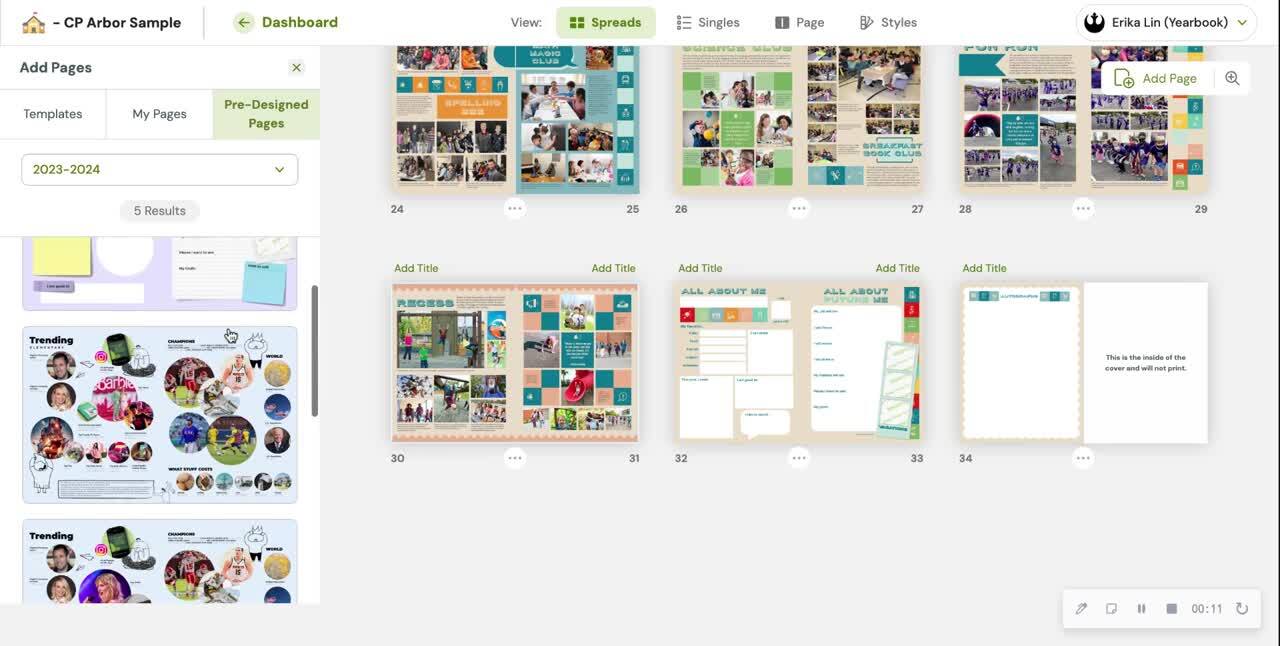
Let It Go... and Celebrate!
Before you hit print ready, ask yourself:
- Do we need to order extra books? (Some schools like to keep a copy in the library.)
- How do we want our books sorted?
- Where should our books be sent?
- When will they arrive and do we need expedited shipping?
Summer
High five! You did it!
QR Code is a registered trademark of DENSO WAVE INCORPORATED.

Summer yearbooking: how to prep
There are two schools of yearbook coordinators: the first, would never click on this blog, and the second, is ready to prep for the following school year. We’re glad you’re ready to lay the foundation for your yearbook over the summer and hope these three steps relieve stress because you’ll enter the school year more prepared than ever, and help you tick off some boxes so you can fully enjoy your summer vacation.
Step 1: Build your Team
Yearbook finished, check! Distribution party a success, check! Use this momentum to recruit a new team. Before you hand out your yearbook staff application, debrief with your current team and state your goals for the upcoming year.
Are you creating a memory book? Be sure to build a team of photographers to capture the emotion behind the events as well as some marketing mavens who will pump up crowdsourcing efforts.
Are you looking to go more journalistic and create a history book? You’ll need writers/reporters in addition to your layout designers and photographers.
Are you creating a spirit book? You’ll want people who are passionate about your school community.
If you lead a student class or club:
- Make sure your recruiting message aligns with your goals
- Highlight the transferable skills
- Solicit recommendations from the faculty as well as your current team
- Build your syllabus and bookmark these rubrics from our free yearbook curriculum
Summer is a great time to do some introductory training with your team. Some advisers do a two- or three-day minicamp and select the theme, colors, and fonts for the year. Others host team-building events to build trust before jumping into design.
If your team is comprised of adults:
- Make sure your recruiting message aligns with your goals
- Set specific expectations for involvement
- Follow up, follow up, follow up
- Offer opportunities for all parents and teachers to contribute

Step 2: Start a Ladder
A ladder is the lifeblood of yearbook organization because it serves two functions:
- It helps you create a schedule
- It helps you determine your page count
From your ladder, you can reverse engineer your yearbook from the final deadline to all the photoshoots that need to be scheduled in between. Since this doc is an overview of the entire book, some yearbook staffs like to post it and use it to check off spreads when they are finished.
Using this yearbook organization module will help you with all the back-end administrivia.
Step 3: Relax and Wait for School to Start
We’re working parents, so we get it: it’s easier said than done. Yes, you’re going to want to solicit summer vacay photos for the yearbook, so grab you-time when you can. From an extra five minutes of privacy in the bathroom to hours with a great book, we wish you well.
To echo the signatures in our yearbooks, have a great summer!
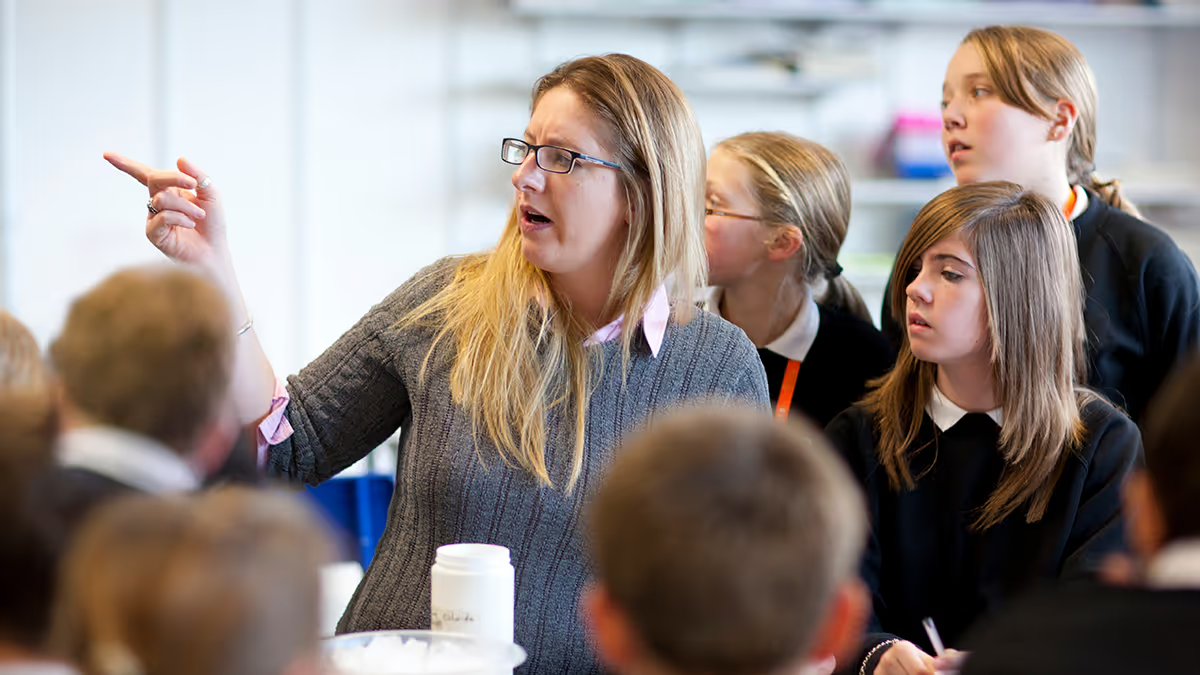
7 things to do when the yearbook is done
Congratulations! The yearbook is done… Now what? I remember the years before I found Treering Yearbooks, when my publisher called in the pages at the end of February. A whole quarter of yearbook students with “nothing” to do was a pedagogical nightmare. Even with a three-week turnaround, Treering advisers everywhere need inspiration, motivation, and a few learning outcomes to finish the year. After talking with several advisers, we compiled this list of things to do to make the end of the year even more meaningful.
1. Keep, Change, Stop
This is a conversation to have with your printed proof in hand. Thumb through as a team, project some spreads on the wall and complete a matrix. What aspects of your program are proverbial home runs and should be keepers? What needs to be changed? (Use this time to brainstorm solutions.) What needs to be stopped?

How it worked in San Diego, CA
After ten years at a K-12 private school, the yearbook staff said they wanted to stop having a purple yearbook. It was a sacred cow we were ready to take off the altar. We color-coded the book in warm reds for the upper school and cool blues for the lower school. When we did the reveal, some of the lifers were enraged until the editor explained, “Blue plus red equals purple.” Cue tears.
It was another five years before we did a purple book again. Had we not had the Keep-Change-Stop conversation, the journalism program would continue to limit its creativity and every book would essentially be a spirit book.
2. Honor the Yearbook Heroes
Grab a stack of thank you cards from the dollar store and take time to recognize the people who helped you create the book, from the office team who gives you the roster at the start of the year to the mom who tirelessly uploads photos from the pick up line. If you are not acknowledging the yearbook heroes on your campus in your colophon, think of a public way to do so:
- School marquee
- Social media post
- Special luncheon
- Send a THNKS a latte
How it worked in Olathe, KS
Being unable to set foot on campus last year was certainly an obstacle, but with the help of our amazing PTO members, school staff, yearbook committee, and community of parents, we were able to still capture the year in a holistic way. We worked with parents to showcase our year in and outside of school.
Because it was a collaborative effort, and we really do have such an awesome community of parents who make this all possible, it was easy to make a video and celebrate our yearbook coordinator through Treering’s #YearbookHero Contest.
3. Make Time for Fun
How many of us Type-A advisers focus on business and forget to play? When the yearbook is finished, it’s the best time to celebrate. Some ideas for stress-releasing fun include:
- Craft time
- Digital escape rooms
- Potlucks
- Game nights
- Sundae bars

How it worked in Clarksville, TN
All of us brought in a board game to play. Our adviser made us rotate for a week and try one another’s. I learned Exploding Kittens, Sequence, and Mancala. It helped us break down the stress of finishing the book and focus on celebrating as a team. After the week, we went back to business and got ready for our signing party.
4. Hold a Social Media Bootcamp
The period between going print-ready and distributing your yearbook is the ideal time to teach new skills, such as social media marketing. If your school has a social presence, adding yearbook-related content is one idea to keep what you and your committee are doing top of mind.
Tweet
Before you bring in a marketing professional or check out a professional course, set the goals and expectations with your team. Do you want to
- Recruit volunteers?
- Sell more yearbooks?
- Crowdsource content?

How it worked in Arlington Heights, IL
Going social was the best thing we did for our yearbook. When I saw the social media calendar, we adopted it, and it increased our followers, which increased our yearbook sales and crowdsourcing efforts.
We also created a hashtag for our yearbook, so if any parents posted a photo—if they used the hashtag—we would consider it for publication. This helped us get a bunch of photos we wouldn’t normally have: boarding the bus, friend groups at events, and cultural events.
5. Brainstorm Evergreen Ideas
Evergreen content for yearbooks is a collection of interview questions, infographic topics, and story ideas that can be used throughout the year. (Here are 40+ to get you started. You’re welcome.)While we want to have a yearbook that reflects the current year and trends, having a timeless collection for reporters and designers serves two purposes:
- Something to do: in that first-of-the-year lull, students can build out evergreen modules and work hard to incorporate less involved students.
- Fill coverage holes: sometimes an event doesn’t happen (hello 2020). Sometimes a student doesn’t cover an event. Sometimes you just have holes. By having a collection from which to draw, you will always have usable content.
How it worked in Williamstown, KY
I remember the first time a student missed an assignment. As a second-year teacher and rookie adviser, I felt like a failure because I didn’t have a contingency plan. My editor actually came up with the idea to have a question of the day. She would text the question in the morning and everyone would ask three students. They would then input the responses into a Google Form.
We kept all the questions related to our theme, Give + Take. They were simple like “Give us your top three songs” or “If you could take a class on anything, what would it be?” Since they were thematic, it was a perfect complement to our book. If we needed a student for coverage or had a blank spot on the spread, we had the material for an instant quote bar. Using Google Forms also allowed us to track and sort the answers by the respondent.
6. I Do, You Do, We Do
I Do, You Do, We Do is a teambuilding idea as well as a way to add in professional growth. It works like this:
- I pick a skill to teach the class and demonstrate it
- You learn and apply the skill
- We do it together

How it worked in Miami, FL
We decided we wanted to use Doodle as our theme for next year and wanted to create coloring book-style pages in the book for dividers and such. None of us are Photoshop pros, so our adviser suggested we learn. Each of us on the editorial team for next year picked a video on YouTube to watch. Then we taught our classmates how to do it. Teaching my friends to do something I just learned made me proud and they listened well.
7. Practice Interviewing
It’s easy to fire off a text that says, “Give me a quote for yearbook,” but yearbook staffs don’t do easy journalism. Spend some time refining your reporting using the yearbook storytelling module of Treering’s free curriculum.
How it worked in Lakeside, CA
Our district hired a branding company to re-do the website, marketing materials, and our social presence. They brought in a photographer to capture student life and take professional headshots of the staff. When the final products came out, they were incomplete. No one knows the Warriors like the Warriors, so I seized an opportunity: hire out my yearbook students.
We wanted to improve our writing, so we created a list of questions to ask teachers and re-wrote all the staff bios for the website.
Your Turn
With these seven actionable ideas, you can find a place of rest going into summer. If you want to get a head start on planning for the fall semester, check out six weeks of yearbook lessons, including rubrics and a yearbook class syllabus.

Teacher appreciation ideas
May 2-6 is Teacher Appreciation Week and it’s time to plan your strategy! An attitude of gratitude can propel the faculty through the last weeks of school. While it’s generally not the yearbook team’s job to organize Teacher Appreciation festivities, we know there are parent contributors and class-act students who love to spread joy.
Yearbook Donation Drive for Teachers
Treering’s donation option makes it easy for families to gift yearbooks to the school. Advisers and coordinators then share the love by distributing yearbooks to staff. Some schools even do an online auction for the principal’s yearbook. Since donated yearbooks won’t arrive during the week, make sure your yearbook team has a card or certificate to present to recipients.
Staff Tributes in the Yearbook
If your yearbook deadline is mid-to-late May, Teacher Appreciation should have coverage. Even if Teacher Appreciation Week comes after your final deadline, you can use the yearbook to showcase your on-campus heroes by:
- Leaving space for staff candids
- Interviewing the Teacher of the Year, department heads, and new members of the faculty
- Highlighting pregnant teachers with a “Future [Mascot]” module

Last-Minute Teacher Appreciation Ideas
We know you’re busy [finishing the yearbook], so here are some no-prep appreciation strategies you can do with your yearbook staff.
- Print and write a postcard (aka a social science lesson on what a postcard is)
- Hold a mini supply drive to replenish teachers’ stock⸺ it can be as simple as cracking open a Costco pack of Expo markers and sharing them among the faculty
- Compile a list of all the free food in your neighborhood so your teachers know where to grab dinner each night
- Create a hall collage with classmates by each bringing in a thank you drawing; if you start small Monday, it could create a movement by Friday
- Use an e-gifting platform such as THNKS to digitally send an 'I Appreciate You' A Latte or a You're Spec-Taco-ular Lunch. It takes seconds.
- Go social: record a video or upload a photo of you and your favorite teacher(s) using #thankateacher, #teacherappreciation, #teacherlove, #weloveourteachers, #thankyouteachers, #teachersrock, #treering
- Download photos and create a slideshow of staff members to display on a screen in the office, on your morning broadcast, or share it with the school community in the May newsletter.
What did you do? Tag us on Facebook and Instagram to share your successes.

Yearbook distribution ideas
You did all the work. You submitted it. And boom: boxes arrive, filled with memories and awaiting signatures. You could deliver a stack to each classroom, wipe your hands, and prep for next year. Or, you could create an epic yearbook distribution and signing party to further cement the yearbook’s role on your campus. Yearbook distribution doesn’t have to be a total mic drop moment (it can), but rather a unifying event to help close the year.
Make Unboxing a Moment
Unboxing the yearbook can help build excitement for yearbook distribution because it tells the campus community the yearbooks are here! A few ideas for social media posts are:
- Put a GoPro or tape your cellphone on the boxes as they get wheeled into the building
- Film your team cracking open the first box (make sure they smell the ink!)
- Photograph a box of yearbooks in various “seats” around campus: the principal’s chair, a student desk, a key locale in the caf
- If your yearbook company doesn’t label your books individually by buyer and organize them by class, do a time-lapse video of your team organizing the books for distribution
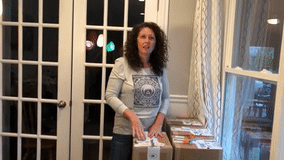
Start Distribution with the Yearbook Team
Being on yearbook staff has to have perks, and one is a fancy-pants dinner before yearbook distribution. (Please note fancy is a relative term: if an Oreo shake is your thing, you’re our kind of people.)
Think of your typical sports banquet: the coach (adviser) stands and speaks a few remarks on the team then hands out the awards. Traditionally, the yearbook staff unwraps their yearbook and shares it with their family. It’s special because they have the first copies and it’s an individualized time for parents to see all the work their child accomplished. Do you have parents creating the yearbook? Celebrate these yearbook heroes!
Distribution Parties
The last month of school is full of events and celebrations, yearbook distribution should be one of the reasons your community comes together. Here are three ideas for yearbook distribution parties our advisers hold, and since we’re all lovers of a good theme, we put together some end-of-the-year playlists for you.
The Extended Lunch
Work with your school’s faculty and administration to add 15-25 minutes to the end of lunchtime for yearbook signing. Create designated areas for each grade with class color-coded pens to distribute the yearbooks and then play music while students mingle.
The Afterschool Special
When yearbook distribution and singing are a family event, you build even more community. Meet at a public park’s gazebo and pass out books and play. Moms hang, kids hang, and the teachers breathe easier because they didn’t have to plan it.

The Bundle and Save
For anyone thinking, “I don’t need one more thing to do,” this is for you: add a yearbook signing party to an existing end-of-the-year event such as award night or an all-school carnival. All you need to do is make a cluster of tables (velvet ropes optional) and have an organized distribution center.
Want to make it next level? Have your distribution area next to a bounce house. Students get their books at the bottom of the slide as they celebrate bouncing to the next grade.
How will you celebrate? Be sure to tag @treering on Facebook and @treeringcorp on TikTok and Instagram to show us.
Some of these ideas originally appeared in our yearbook traditions blog.
